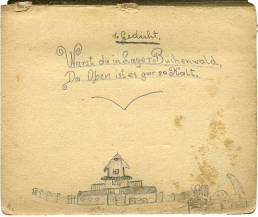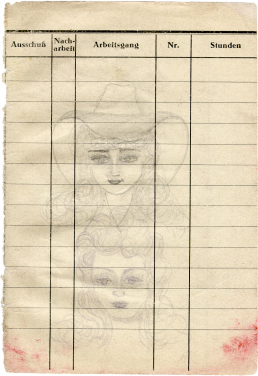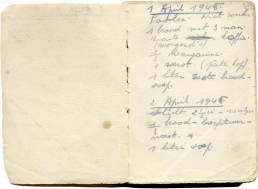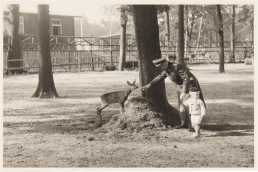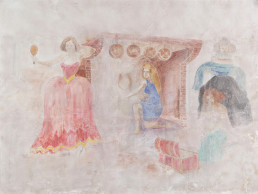In order to escape the grim reality of life in the camp, which was characterized by violence and the fear of death, many children and young people tried to create a world using their fantasy or by playing games. Some also created fantasy worlds through drawing.
For the children and young people who had been deported to the concentration camp alone, contact with fellow prisoners was essential to maintain the will to survive. The young prisoners gave each other hope and comfort. Contacts with adult prisoner functionaries with influence were also essential for survival.
"Warst du im Lager Buchenwald, da oben ist es gar so kalt" (If you were in the Buchenwald camp, it's so cold up there). Poem and drawing by Johann Stojka, 26 February 1945.
The 15-year-old Rom was deported from Auschwitz to Buchenwald with his brother in the summer of 1944. He recorded his experiences with verses and drawings in a notebook. His poem ends on a hopeful note with the words, “We’ll get out after all.” The two brothers were the only members of their family to survive.
(Kazerne Dossin, Mechelen)
Drawing by Maria Brzęcka from the Meuselwitz subcamp, 1944/45.
To escape the reality of the Meuselwitz women’s camp, Maria Brzęcka, then 14 years old, drew. Using a small pencil and old inspection slips from the factory where she had to do forced labor, Maria created her “own dream world.” She drew scenes from life before the war, which she had older fellow prisoners describe to her. She also made drawings of extravagant female figures, many of which have been preserved.
(Buchenwald Memorial)
Diary of Leopold Claessens, 1-2 April 1945.
Secretly keeping diaries or notes was also a strategy of self-preservation and survival. The Belgian teenager Leopold Claessens was deported to the Mittelbau-Dora Concentration Camp as a political prisoner at the age of 19. In April 1945, he survived an evacuation transport to the Bergen-Belsen Concentration Camp. He started the diary in Bergen-Belsen, writing in retrospect, and recorded what he was given to eat
(private property)
Flowers for Bread. Franz Rosenbach in an interview with the USC Shoah Foundation, 23 October 1998.
The Sinto Franz Rosenbach arrived at Mittelbau-Dora when he was 17. In the camp, hunger was a constant companion. To supplement his meager bread ration, he began picking flowers in his free time and exchanging them with the block elder for bread. Contact with the privileged prisoner functionaries could be essential for survival.
(Visual History Archive)
"With Daddy at the Zoo." Camp commander Karl Otto Koch with his son Artwin at the Buchenwald zoo, October 1939.
In 1938, the SS built a zoo on the Ettersberg. It served as a recreational facility for the SS and their families. While opportunities to play were limited for the children suffering in the camp, the children of the SS personnel amused themselves at the zoo just outside the camp fence.
(Buchenwald Memorial)
"Humor was an essential part of our mental resistance. And this mental resistance was, in short, a necessity for having the will to live. I tell you this as an ex-prisoner. No matter how rarely it occurred, how sporadically or how spontaneously, it was of great importance. Of very great importance!"
Humor as a means of survival. Felicija Karay in an interview, c. 2000.
From July 1944 to April 1945, 17-year-old Felicija Schächter (married name Karay) worked as a forced laborer for HASAG Leipzig. In an interview with psychologist Chaya Ostrower, she described humor as a means of mental resistance.
(Chaya Ostrower: It Kept Us Alive. Humor in the Holocaust, Wiesbaden 2018).
"Hasag is our father,
The best father there is!
He promises us
Long years of happiness,
Chorus:
The command’s for
Law and order, no more!
That we calm our nerves
Before we become
A can of preserves […]
HASAG Hymn. Prisoners’ humorous song, before 1945.
The women and girls who worked as forced laborers in the HASAG Leipzig subcamp wrote a humorous anthem, which they often sang together. It satirized the conditions in the camp.
Felicija Karay: Hasag Leipzig Slave Labour Camp for Women: The Struggle for Survival, Told by the Women and Their Poetry, Vallentine Mitchell & Co Ltd, 2003).
Scene from the fairy tale Snow White. Plaster fresco by French prisoner Georges Sanchidrian in the Ellrich-Juliushütte subcamp, 1944.
Georges Sanchidrian made colored murals on the plastered walls in Block 4 of the Mittelbau-Dora subcamp. Some frescoes with fairy tale scenes survived. Both adults and juvenile prisoners were housed in the block. Sanchidrian (born 1905) died on a death march in April 1945.
(German Historical Museum)
